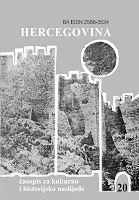SPOMENICI I NJIHOVO OZNAČAVANJE TERITORIJE I(LI) KAKO BRANITI IDENTITETE
MONUMENTS AND THEIR MARKING OF THE TERRITORY AND (OR) HOW TO DEFEND IDENTITIES
Author(s): Majda Turkić, Bernard HarbašSubject(s): Cultural history, Social history, Social Theory, Rural and urban sociology, Sociology of Culture, Identity of Collectives
Published by: Fakultet humanističkih nauka, Univerzitet »Džemal Bijedić« u Mostaru
Keywords: Identity; monuments; spatiality; city;
Summary/Abstract: Identity is capable of being observed and defined through several unique characteristics, affiliations, or social roles. The most common denominator involves having a sense of belonging to the same nation or community sharing common historical threads, based on a (perceived) sense of inclusivity, nurtured and perpetuated through the feeling of connectedness to common past events. Arising from such perceptions is the narrative of ethnic, religious, cultural, and multidimensional community, often publicly displayed or widely used in favor of economic, political, and national empowerment. Another type of self-identification relates to the perception of belonging to a physical place, which embeds the appearance of solidarity and physical space sharing with others in the same vicinity. Within this physical area, the central role is played by the city and its symbolism of cultural, religious, and economic objects. Thus, the question of the “right to the city” becomes central to comprehending the malicious (use) of infrastructural facilities or historical symbols in the context of constructing one’s identity and controlling national aspirations, also serving to re-design desired collective identities through the change/manipulation of collective consciousness
Journal: Hercegovina
- Issue Year: 2021
- Issue No: 20
- Page Range: 193-200
- Page Count: 8
- Language: Bosnian

